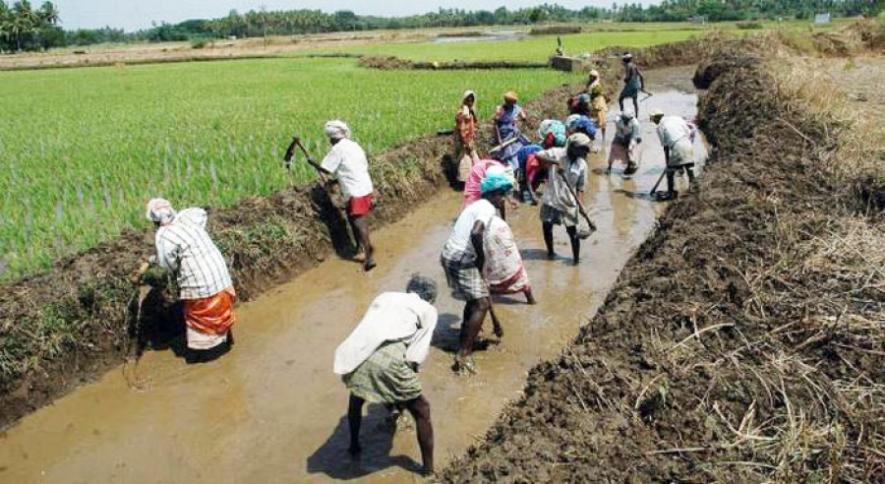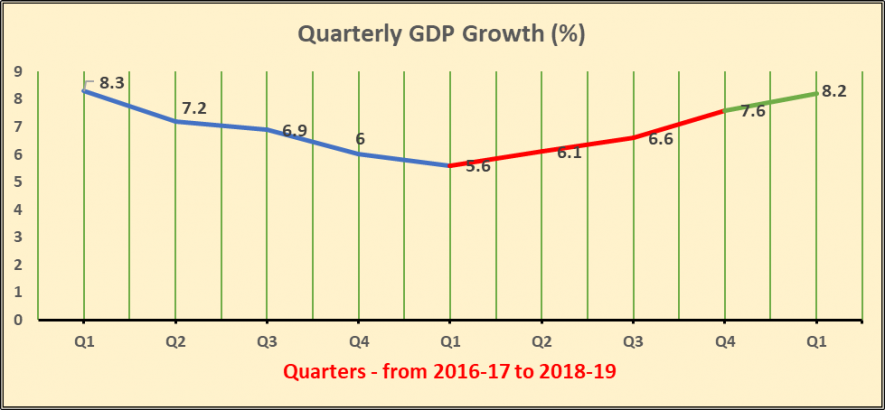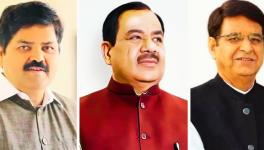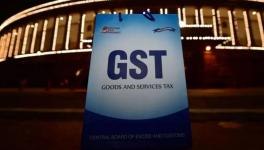GDP Growth Rate: A Crown of Thorns

GROWTH FOR WHOM: Recent years have seen the most severe economic crisis as farmers' net incomes have decimated, while workers wages are also stagnating.
There is much celebration in government circles and, of course, in the mainstream media, that in the first quarter of 2018-19 (April to June 2018), the GDP growth rate picked up to touch 8.2% compared with the same quarter last year (April to June 2017). There is talk and tweets on “Modi ji’s astute leadership” and India being catapulted on to “the path of unparalleled Growth Story” (whatever that means)ne. One is hearing the same old refrain that India is the ‘fastest growing economy’, etc.
Two things need to be noted amidst this rather extraordinarily hyped exuberance. The first is a sort of statistical point of order, while the second is a far more serious contextualising of these numbers.
First, take a look at the chart below which shows quarterly growth since the beginning of 2016-17. The current 8.2% growth rate is in relation to what the GDP growth rate was in the first quarter of last year, which – as you will note in the chart – was a period of slump. Growth had petered down to just 5.6% in that quarter. As anyone with a rudimentary sense of numbers will realise, growth in comparison to a low starting point will always be higher. Economists call this the base effect.

So, the celebrations need to be tempered a bit. After all, as the chart also shows, GDP growth is now back to where it was two years ago. Modi ji’s sagacity and astute economics have led the country downhill, and now that the economy is returning back to its original position, is it a matter of celebration?
But, more importantly, what is the relationship of these GDP numbers to the real economy? Once you ask this question, the whole house of cards crumbles. The ‘fastest growing’ tag, therefore, is nothing but a crown of thorns.
Just as in the United Progressive Alliance-II era, high growth is going hand in hand with one of the most severe crises of jobs. Despite the ill-conceived and often ludicrous government propaganda that jobs are being created, the reality is that India’s workforce has declined, joblessness is at a high, and there are no immediate prospects of jobs being available even as 12 million persons continue to relentlessly swell the army of job seekers every year.
Why is it that the GDP rate is growing while jobs are shrinking? The answer, in short, lies in the nature of GDP expansion. It is being driven not by the expansion of the manufacturing sector, nor even by the usually sleepy agriculture sector. It is not expanding due to a ‘concerned’ government spending more. In fact, all these would have created more jobs.
The kind of GDP expansion we are witnessing now is primarily being driven by private consumption expenditure which grew by about 8.6% in this first quarter while government consumption expenditure increased by 7.6%. Government spending has stagnated at a share of 11.8% of the total GDP at constant prices in this quarter. It was the same in the Q1 of last year. Private spending share in GDP has inched up from 54.7% in Q1 of last year to 54.9% this year. With this lag, the government seems clearly gripped by a virtual paralysis.
But the real economy is not just about jobs. What about incomes? Workers’ wages are stagnating and are mostly below the accepted standard norms in most states. Even the government’s own employees start off from the barest minimum wage, although this is usually the highest wage available in general. That’s why 28 million people applied for 100,000 railway jobs.
Agricultural wages have been stagnating or growing very marginally. Remember, agricultural workers number over 15 crore – some 55% of the rural workforce. Between 2014-15 and 2016-17, real (inflation adjusted) wages of agricultural workers have increased by just 1.7% for ploughing, 3.1% for sowing, transplanting and weeding, 0.5% for harvesting, winnowing and threshing, and 2% for unskilled labour.
As regards farming, the recent years have seen the most severe economic crisis as farmers in over a dozen states came out on to the streets protesting against high input costs and low returns which have decimated their net incomes.
It is because of these multiple crises that working people of the country are up in arms, with a mammoth protest slated next week (on 5th September) in Delhi by workers and farmers together. They are demanding an end to the neo-liberal policies of the Modi government – the same policies that create high GDP growth but no jobs, no increase in incomes and overall pauperisation for the people.
Get the latest reports & analysis with people's perspective on Protests, movements & deep analytical videos, discussions of the current affairs in your Telegram app. Subscribe to NewsClick's Telegram channel & get Real-Time updates on stories, as they get published on our website.
























